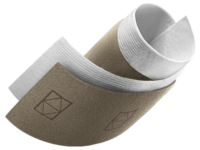Venous leg ulcers go beyond the wound: Understand the impacts on quality of life
What can you do to help patients cope with the challenges of venous stasis?

Chronic venous insufficiency is a lifelong disease that can lead to painful and costly venous leg ulcers (VLU). When a VLU develops, treatment can take weeks or even months to heal. But while you’re focused on healing the patient’s wound, your patient may be more concerned about how the wound affects their life.
Studies show that people living with venous leg ulcers report a long list of negative impacts.
Here are some of the challenges patients reported:¹
- Heavy leakage from wounds causing concerns about social settings
- Discomfort from bandages, restricting physical activities
- Sleeplessness due to pain or worry
- Unpleasant smell from wounds causing embarrassment, higher anxiety and depression
- Pessimistic view of the future or feelings of a hopeless situation
- Loss of control and self-identity
- Lost days of work, especially by younger people
68%
said ulcers had a negative emotional impact on their lives²
42%
said their ulcer contributed to the decision to stop working¹
VLUs and depression
A common feeling among people with venous leg ulcers is depression and hopelessness surrounding their healing.¹
It makes sense, considering how often a wound recurs even after it seems to have healed. For individuals with venous leg ulcers, healing doesn’t mean the same thing as it does to people with acute wounds. For them, healing comes with uncertainty and fear of recurrence.
One of the biggest challenges to healing venous leg ulcers is that patients don’t comply with he standard treatment method: compression. Compression can be uncomfortable for many patients. Which means you can wrap a person’s leg every time you see them, but if they’re not keeping it wrapped for the proper number of days, or they’re not using the right at-home compression garment, then healing may be stalled.
Be sure to start your clinical therapy with the right compression devices, such as AccuWrap, which comes with accuracy indicators to confirm when the ideal compression is applied. Then, when your patients are ready to manage their own compression, it’s even more important to set them up for success by providing at-home compression devices that are easy to put on, easy to adjust and comfortable enough to wear consistently. Look for more innovative products that keep patients’ needs top of mind, such as COMPRECARES, which features an adjustable tab and special wicking fabric.
Remember that proper nutrition can support healing. If patients or residents are malnourished, a clinical supplement can go a long way to providing the protein they need to promote optimal health.
When patients don’t see progress on their wounds, they can once again feel depressed and hopeless, and their quality of life suffers.
Could a club help patients cope with venous leg ulcers?
In 1995, a nurse in Suffolk, England, established what she called a Leg Club. It was centered around “community-based leg ulcer care” and delivered care in more of a support-group, non-medical environment. There are now a number of these facilities in Europe and Australia.
The patients at these clubs are referred to as “members,” a term meant to help people take more ownership of their treatment.³ The facilities provide places to sit, have some coffee and talk with other people who are going through similar challenges to their own.
While more research is warranted on whether a support group model of care for people with venous stasis could be appropriate on a larger scale, there’s some positive anecdotal support for it. According to data from a randomized controlled trial, “Participants who received care under the Leg Club model demonstrated significantly improved outcomes in quality of life, self-esteem, healing, pain and functional ability.”4

Shift perspectives to help patients
Wherever you provide care for people with venous leg ulcers, consider how a support group could have some relevance. If that’s not available, try shifting your thinking to put yourself in your patient’s shoes.
Along with evidence-based best practices:
- Offer patients empathy and understanding of the many ways venous stasis affects their quality of life.
- Educate patients on their disease.
- Ask questions about their lives at home.
- Help connect patients with other people who have venous stasis.
- Encourage compliance to compression with user-friendly compression garments.
The bottom line: One of the keys to helping people cope with their lifelong disease could be your understanding that just as the effects go beyond the wound, perhaps healing goes beyond clinical interventions.
Key takeaway
You know that managing venous leg ulcers takes consistent compression. But venous stasis is a disease that’s about more than a wound. This lifelong disease affects patient wellbeing on many levels. That’s why it’s important to consider quality of life issues. It goes back to that popular nurse saying: You can’t just treat the hole in the person; you have to treat the whole person.
Learn more about treating lower extremity wounds :
Watch the webinar—Compression: Why, when and how
Compression therapy for venous stasis: 3 ways to encourage patient compliance
Share this education handout with patients
Venous leg ulcers: 4 ways to help improve patient compliance and quality of life
References:
- Herber, O. R., Schnepp, W., & Rieger, M. A. (2007). A systematic review on the impact of leg ulceration on patients’ quality of life. Health and Quality of Life Outcomes, 5(1). Available at https://doi.org/10.1186/1477-7525-5-44
- Platsidaki, E., Kouris, A., & Christodoulou, C. (2017). Psychosocial Aspects in Patients With Chronic Leg Ulcers. WOUNDS: A Compendium of Clinical Research and Practice, 29(10). Available at https://doi.org/10.25270/wnds/2017.10.306310
- Lindsay, E. (2004). The Lindsay Leg Club® Model: a model for evidence-based leg ulcer management. British Journal of Community Nursing, 9(Sup2), S15–S20. Available at https://doi.org/10.12968/bjcn.2004.9.sup2.13128
- Edwards, H., Courtney, M., Finlayson, K., Shuter, P., & Lindsay, E. (2009). A randomised controlled trial of a community nursing intervention: improved quality of life and healing for clients with chronic leg ulcers. Journal of Clinical Nursing, 18(11), 1541–1549. Available at https://doi.org/10.1111/j.1365-2702.2008.02648.
